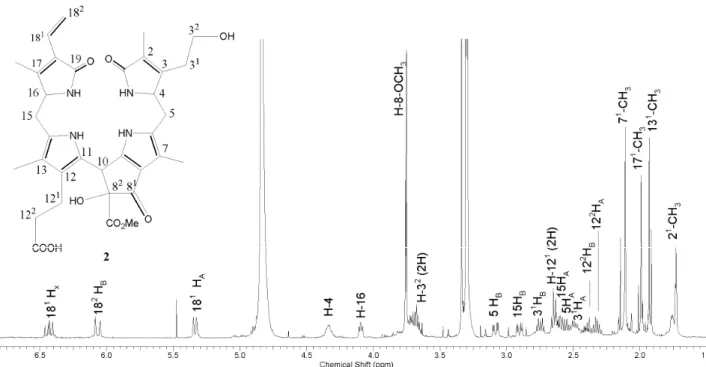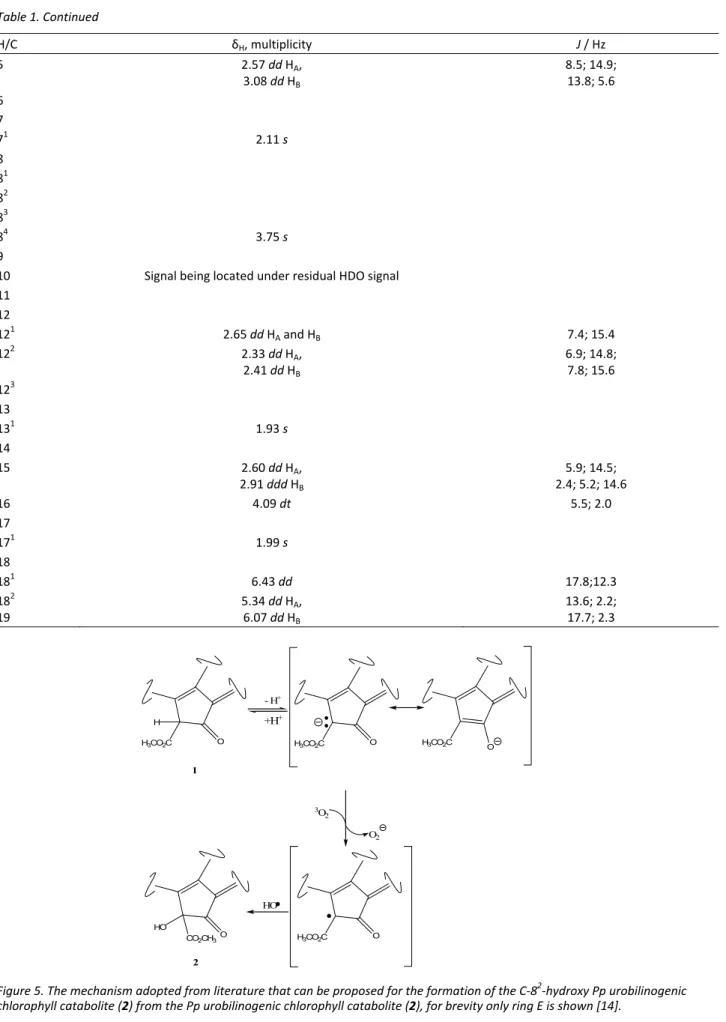Urobilinogenic chlorophyll catabolite behavior in oxygen-containing
moiety
Nina M. Djapic
University of Novi Sad, Technical Faculty “Mihajlo Pupin”, Zrenjanin, Serbia
Abstract
The urobilinogenic chlorophyll catabolite being exposed to oxygen-containing moiety, after three months, forms the C-82-hydroxy urobilinogenic chlorophyll catabolite. The chromato-graphic and spectroscopic methods have been used to study the hydroxylated urobilino-genic chlorophyll catabolite product formed. Using liquid chromatography–mass spectro-metry and nuclear magnetic resonance spectroscopy C-82 hydroxylated urobilinogenic chlorophyll catabolite was identified. Analysis of the results obtained enables the pro-positions of the reaction mechanism.
Keywords: urobilinogenic chlorophyll catabolite, C-82hydroxylation.
SCIENTIFIC PAPER
UDC 543.4:581.19:66.094.32
Hem. Ind.68 (1) 77–82 (2014)
doi: 10.2298/HEMIND130118029D
Available online at the Journal website: http://www.ache.org.rs/HI/
The oxidation of chlorophylls by molecular triplet oxygen in aqueous methanol solutions happens to all chlorophylls that have an intact β-ketoester structure at the isocyclic ring [1]. The first oxidation product formed is the hydroxylated chlorophylls’ derivative. The oxidation process continues further and the reaction was named the allomerization [2]. The allomerization occurs through chemical or enzymatic pathway and a complex mixture of products is formed [3]. An early stage reaction in chlorophyll breakdown, under natural conditions, is the allomerization [4,5]. The reversed- -phase (RP) and normal phase (NP) high-performance liquid chromatography (HPLC) was utilized in the sepa-ration of chlorophyll allomers [6,7]. The HPLC coupled with mass spectrometry (HPLC–MS) in conjunction with UV–Vis absorption has been used for analysis of chloro-phyll allomers [8–10]. The nuclear magnetic resonance (NMR) spectroscopy was used in assignment of several allomers [11–13]. The allomerization is initiated in aqueous methanol solution containing traces of bases, acids and metals. The base catalyzed allomerization mechanism comprises the removal of the acidic α -pro-ton at chlorophylls’ C-132 position and formation of an enolate. After keto-enol tautomerization of the C-131=C-132 double bond the allomer is formed. Free radical mechanism was proposed for the allomerization [14]. Further investigations support an idea of alter-native allomerization pathway [10]. There is still not enough data to back up proposed acid catalyzed allo-merization mechanism of chlorophylls. The urobilino-genic chlorophyll catabolite isolated from the Parrotia persica autumnal leaves differs from chlorophylls and
Correspondence: University of Novi Sad, Technical Faculty “Mihajlo Pupin”, Djure Djakovica bb, 23000 Zrenjanin, Serbia.
E-mail: djapic@tfzr.uns.ac.rs Paper received: 18 January, 2013 Paper accepted: 15 April, 2013
chlorophyll catabolites by having one carbon atom less [15]. The Parrotia persica urobilinogenic chlorophyll catabolite structure (1) refers to urobilinogen and the carbon atom numeration is the same as in urobilino-gen. The C-82 hydroxylation of Parrotia persica urobili-nogenic chlorophyll catabolite in deutero methanol containing traces of water and acid is described in this paper. RP LC-MS and 1H-NMR spectra were used in the identification of C-82-hydroxy urobilinogenic chloro-phyll catabolite (2) and the mechanisms that can explain the formation of the C-82-hydroxy urobilino-genic chlorophyll catabolite are proposed.
MATERIALS AND METHODS
The urobilinogenic chlorophyll catabolite was iso-lated from Parrotia persica (Pp), Hamamelidaceae autumnal leaves according to the methods described previously [15]. The isolated Pp urobilinogenic chloro-phyll catabolite was left for 3 months in the NMR tube, in the cold and dark place. After 3 months the RP LC– –MS analysis was done. The LC chromatogram revealed the presence of two compounds. The final purification was done by RP HPLC using Waters 600 HPLC system coupled with Waters 2996 PDA UV–Vis detector (Waters Corp., Milford, USA) and RP EP 250 mm×16 mm Nucleosil 100-7 C8 column along with RP EP 30
mm×16 mm Nucleosil 100-7 C8 precolumn (Macharey-
-Nagel, Oesingen, Switzerland). The detection wave-length was set at 244 nm, temperature of the column was kept at 22 °C and the injection volume was 2 ml via
Belgium). The recording of the 1H-NMR spectrum was done under the same conditions as described pre-viously [15].
RESULTS AND DISCUSSION
The Parrotia persica (Pp) urobilinogenic chlorophyll catabolite (1) was, after recording of the NMR spectra, left in the cold and dark place for 3 months. After 3 months the RP LC–MS chromatogram was recorded. The chromatogram revealed the presence of two com-pounds (Figure 1).
Methanol and acidified water eluent can influence the formation of hydrogen bonds in the solution and reduce the interactions between compounds. The sta-tionary phase particle surface can form hydrogen bonds with the compounds being separated. The pro-longed retention time of the C-82-hydroxy urobilino-genic chlorophyll catabolite (2) can be attributed to additional hydroxyl group present that can form hyd-rogen bond with the silanol sites of the column pack-ing. The ESI-MS showed a molecular ion at m/z 633, an [M+H]+ for the Pp urobilinogenic chlorophyll catabolite (1), Figure 2. C-82-hydroxy derivative showed a
mole-cular ion at m/z 651, an [M+H]+ for the C-82-hydroxy Pp
urobilinogenic chlorophyll catabolite (2). The sample was subsequently purified by semi-preparative HPLC under the same conditions as described previously [15].
The 1H-NMR spectra were recorded for all purified compounds. The 1H-NMR spectra of the Pp urobilino-genic chlorophyll catabolite (1) and its C-82-hydroxy derivative (2) are depicted in Figures 3 and 4, respecti-vely.
The difference between the two 1H-NMR spectra is the absence of the signal for the C-82 proton in the C-82-hydroxy Pp urobilinogenic chlorophyll catabolite (Figure 4). The chemical shifts, multiplicity and coupling constants of the Pp urobilinogenic chlorophyll cata-bolite (1) were as published previously [15]. The che-mical shifts, multiplicity and coupling constants of the isolated C-82-hydroxy Pp urobilinogenic chlorophyll catabolite (2) are depicted in Table 1.
In chlorophylls, the acidic catalyzed allomerization mechanism is comprised of protonation of the C-131 oxo group. This mechanism was not sufficient to explain the formation of the C-132-hydroxy and C-132- -methoxy chlorophylls [10]. The other mechanism pro-posed for the allomerization of chlorophylls was a free
0 10 20 30 40 50 60 70 80 Time [min]
0 50 100 150 200 250 Intens. mAU
Figure 1. The chromatogram of the Pp urobilinogenic chlorophyll catabolite and its C-82-hydroxy derivative separated on the analytical RP C8 column. Conditions: mobile phase: water (0.1 % TFA): methanol, gradient elution, the proportion of methanol was
increased linearly from 10 to 100% in 70 min and in next 20 min elution was continued with methanol. The column temperature was 22 °C, flow rate 0.2 ml/min, detection. UV 244 nm, injection: 10 μl via autosampler.
633.4
0.0 0.5 1.0 1.5 2.0 6 x10 Intens.
250 500 7
242.3
381.2
651.4
0.0 0.2 0.4 0.6 0.8 1.0 6 x10 Intens.
250 500 750
Figure 3. The 1H-NMR spectrum of Pp urobilinogenic chlorophyll catabolite (1).
Figure 4. The 1H-NMR spectrum of the C-82-hydroxy Pp urobilinogenic chlorophyll catabolite (2).
Table 1. 1H-NMR (500 MHz) data in CD3OD of the isolated C-8 2
-hydroxy Pp urobilinogenic chlorophyll catabolite (2)
H/C δH, multiplicity J / Hz
1 1.73 s
2 21
3 2.49 dd HA,
2.75 dd HB
6.9; 14.8, 6.6; 13.8 31
32 3.68 m HA and HB
Table 1. Continued
H/C δH, multiplicity J / Hz
5 2.57 dd HA,
3.08 dd HB
8.5; 14.9; 13.8; 5.6 6
7
71 2.11 s
8 81
82 83
84 3.75 s
9 10 Signal being located under residual HDO signal
11 12
121 2.65 dd HA and HB 7.4; 15.4
122 2.33 dd HA,
2.41 dd HB
6.9; 14.8; 7.8; 15.6 123
13
131 1.93 s
14
15 2.60 dd HA,
2.91 ddd HB
5.9; 14.5; 2.4; 5.2; 14.6
16 4.09 dt 5.5; 2.0
17
171 1.99 s
18
181 6.43 dd 17.8;12.3
182 19
5.34 dd HA,
6.07 dd HB
13.6; 2.2; 17.7; 2.3
O H
H3CO2C
- H+
+H+
O
H3CO2C H3CO2C
3O
2
O2
O H3CO2C
O
HO.
O
CO2CH3
HO
1
2
radical one (Figure 5), which was able to explain the formation of the previously mentioned chlorophyll allomers [14].
CONCLUSIONS
The evidences described, clearly indicated that the
Pp urobilinogenic chlorophyll catabolite (1), under the acidic conditions, in the presence of trifluoroacetic acid (TFA), which was used as a modifier during the chro-matographic separation, in aqueous methanol solution upon standing for months induces the formation of the C-82-hydroxy Pp urobilinogenic chlorophyll catabolite (2). The mechanism proposed for the allomerization of chlorophylls can explain the formation of the C-82- -hydroxy Pp urobilinogenic chlorophyll catabolite (2). The chromatographic and spectroscopic methods des-cribed can facilitate the identification of the C-82 -hyd-roxy urobilinogenic chlorophyll catabolite (2).
REFERENCES
[1] R. Willstaetter, A. Stoll, Untersuchungen ueber Chloro-phyll, Springer, Berlin, 1913, p. 29.
[2] L.G. Johnston, W.F. Watson, The allomerization of chlo-rophyll, J. Chem. Soc. 1956 (1956) 1203–1212.
[3] F.C. Pennington, H.H. Strain, W.A. Svec, J.J. Katz, Prepa-ration and properties of 10-hydroxychlorophylls a and b, J. Am. Chem. Soc. 89 (1967) 3875–3880.
[4] G.A. Hendry, J.D. Houghton, S.B. Brown, The Degra-dation of Chlorophyll – a Biological Enigma, New Phytol.
107 (1987) 255–302.
[5] M.N. Merzlyak, V.A. Kovrizhnikh, K.N. Timofeev, Super-oxide mediated chlorophyll allomerization in a dimethyl sulphoxide-water mixture, Free Rad. Res. Commun. 15
(1991) 197–201.
[6] P.M. Schaber, J.E. Hunt, R. Fries, J.J. Katz, High-per-formance liquid-chromatography study of the
chloro-phyll allomerization reaction, J. Chromatogr. 316 (1984) 25–41.
[7] P. Kuronen, K. Hyvarinen, P. H. Hynninen, I. Kilpelainen, High Performance Liquid Chromatographic Separation and Isolation of the Methanolic Allomerization Products of Chlorophyll a, J. Chromatogr. 654 (1993) 93–104. [8] R.B. van Breeman, F.L. Canjura, S.J. Schwartz,
High-performance liquid chromatography – continuous flow fast atom bombardment mass spectrometry of chloro-phyll derivatives, J. Chromatogr. 542 (1991) 373–383. [9] A. Rahamani, C. B. Eckardt, R. G. Brereton, J. R. Maxwell,
The Use of Liquid Chromatography-Mass Spectrometry to Monitor the Allomerization Reactions of Chlorophyll a and Pheophytin a: Identification of the Allomers of Pheophytin a, Photochem. Photobiol. 57 (1993) 1048– –1052.
[10] R.G. Brereton, A. Rahamani, Y.Z. Liang, O.M. Kvalheim, Investigation of the allomerization reaction of chloro-phyll a: use of diode array HPLC, mass spectrometry and chemometric factor analysis for the detection of early products, Photochem. Photobiol. 59 (1994) 99–110. [11] I. Kilpelainen, S. Kaltia, P. Kuronen, K. Hyvarinen, P. H.
Hynninen, Assignment of the 1H and 13C NMR spectra of 132(R)-methoxychlorophyll a using the two-dimen-sional HMQC and HMBC techniques, Magn. Reson. Chem. 32 (1994) 29–35.
[12] J. Helaja, K. Hyvarinen, S. Heikkinen, I. Kilpelainen, P.H. Hynninen, Solution Structures of 13(2)-methoxy Chloro-phyll a Epimers, J. Mol. Struct. 354 (1995) 71–79. [13] K. Hyvarinen, J. Helaja, P. H. Hynninen, An Unexpected
Allomer of Chlorophyll: 132(S)-Hydroxy-10-Methoxy chlorophyll b, Tetrahedron Lett. 39 (1998) 9813–9814. [14] P.H. Hynninen, Mechanism of the Allomerization of
Chlorophyll: The inhibition of the Allomerization by Carotenoids Pigments, Z. Naturforsch., Teil B 36 (1981) 1010–1016.
[15] N. Djapic, M. Pavlovic, Chlorophyll catabolite from Parrotia persica autumnal leaves, Rev. Chim. (Bucuresti)
IZVOD
PONAŠANJE UROBILINOGENSKOG KATABOLITA HLOROFILA U ATMOSFERI KOJA SADRŽI KISEONIK
Nina M. Đapić
Univerzitet u Novom Sadu, Tehnički fakultet „Mihajlo Pupin“, Zrenjanin, Srbija
(Naučni rad)
Urobilinogenski katabolit hlorofila stajanjem u atmosferi koja sadrži kiseonik, nakon tri meseca, formira C-82-hidroksi urobilinogenski katabolit hlorofila. Koriš-ćene su hromatografske i spektroskopske metode za proučavanje formiranog hid-roksi urobilinogenskog katabolita hlorofila. Upotrebom tečne hromatografije-masene spektrometrije i nuklearne magnetne rezonantne spektroskopije identifi-kovan je C-82-hidroksi urobilinogenski katabolit hlorofila. Dobijeni rezultati uka-zuju da urobilinogenski katabolit hlorofila izolovan iz jesenjeg lišća biljke Parrotia persica u prisustvu tragova kiseline, koja je korišćena kao modifikator tokom hro-matografskog razdvajanja, u vodenom rastvoru metanola i u atmosferi koja sadrži kiseonik nakon nekoliko meseci stajanja uzrokuje stvaranje C-82-hidroksi urobili-nogenskog katabolita hlorofila. Analiza dobijenih rezultata omogućava predlog reakcionog mehanizma. Mehanizam kiselo katalizovane alomerizacije hlorofila podrazumeva protonovanje C-131 okso grupe. Ovaj mehanizam nije mogao da objasni stvaranje C-132-hidroksi i C-132-metoksi hlorofila. Drugi predložen meha-nizam podrazumeva alomerizaciju hlorofila po slobodno radikalskom mehanizmu koji je mogao da objasni stvaranje prethodno navedenih alomera hlorofila.


